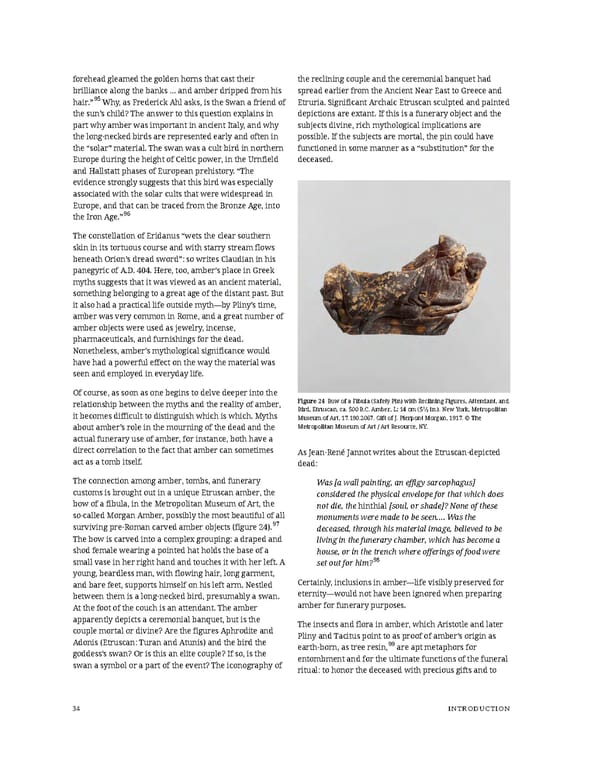forehead gleamed the golden horns that cast their the reclining couple and the ceremonial banquet had brilliance along the banks … and amber dripped from his spread earlier from the Ancient Near East to Greece and hair.”95 Why, as Frederick Ahl asks, is the Swan a friend of Etruria. Significant Archaic Etruscan sculpted and painted the sun’s child? The answer to this question explains in depictions are extant. If this is a funerary object and the part why amber was important in ancient Italy, and why subjects divine, rich mythological implications are the long-necked birds are represented early and often in possible. If the subjects are mortal, the pin could have the “solar” material. The swan was a cult bird in northern functioned in some manner as a “substitution” for the Europe during the height of Celtic power, in the Urnfield deceased. and Hallstatt phases of European prehistory. “The evidence strongly suggests that this bird was especially associated with the solar cults that were widespread in Europe, and that can be traced from the Bronze Age, into the Iron Age.”96 The constellation of Eridanus “wets the clear southern skin in its tortuous course and with starry stream flows beneath Orion’s dread sword”: so writes Claudian in his panegyric of A.D. 404. Here, too, amber’s place in Greek myths suggests that it was viewed as an ancient material, something belonging to a great age of the distant past. But it also had a practical life outside myth—by Pliny’s time, amber was very common in Rome, and a great number of amber objects were used as jewelry, incense, pharmaceuticals, and furnishings for the dead. Nonetheless, amber’s mythological significance would have had a powerful effect on the way the material was seen and employed in everyday life. Of course, as soon as one begins to delve deeper into the relationship between the myths and the reality of amber, Figure 24 Bow of a Fibula (Safety Pin) with Reclining Figures, Attendant, and Bird, Etruscan, ca. 500 B.C. Amber, L: 14 cm (51⁄2 in.). New York, Metropolitan it becomes difficult to distinguish which is which. Myths Museum of Art, 17.190.2067. Gift of J. Pierpont Morgan, 1917. © The about amber’s role in the mourning of the dead and the Metropolitan Museum of Art / Art Resource, NY. actual funerary use of amber, for instance, both have a direct correlation to the fact that amber can sometimes As Jean-René Jannot writes about the Etruscan-depicted act as a tomb itself. dead: The connection among amber, tombs, and funerary Was [a wall painting, an effigy sarcophagus] customs is brought out in a unique Etruscan amber, the considered the physical envelope for that which does bow of a fibula, in the Metropolitan Museum of Art, the not die, the hinthial [soul, or shade]? None of these so-called Morgan Amber, possibly the most beautiful of all monuments were made to be seen.… Was the surviving pre-Roman carved amber objects (figure 24).97 deceased, through his material image, believed to be The bow is carved into a complex grouping: a draped and living in the funerary chamber, which has become a shod female wearing a pointed hat holds the base of a house, or in the trench where offerings of food were small vase in her right hand and touches it with her left. A set out for him?98 young, beardless man, with flowing hair, long garment, and bare feet, supports himself on his left arm. Nestled Certainly, inclusions in amber—life visibly preserved for between them is a long-necked bird, presumably a swan. eternity—would not have been ignored when preparing At the foot of the couch is an attendant. The amber amber for funerary purposes. apparently depicts a ceremonial banquet, but is the The insects and flora in amber, which Aristotle and later couple mortal or divine? Are the figures Aphrodite and Pliny and Tacitus point to as proof of amber’s origin as Adonis (Etruscan: Turan and Atunis) and the bird the earth-born, as tree resin,99 are apt metaphors for goddess’s swan? Or is this an elite couple? If so, is the entombment and for the ultimate functions of the funeral swan a symbol or a part of the event? The iconography of ritual: to honor the deceased with precious gifts and to 34 INTRODUCTION
 Ancient Carved Ambers in the J. Paul Getty Museum Page 43 Page 45
Ancient Carved Ambers in the J. Paul Getty Museum Page 43 Page 45